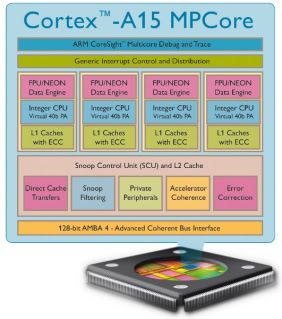Dual Core ARM Cortex A15 SoC may outperform Quad core A9 chips
Even though there is still more than a year left until the first SoC designs based on ARM’s Cortex A15 core make their way into mobile devices, recent reports suggest these chips are expected to deliver quite an important performance increase over the current Cortex A9 processors.
According to information provided by unnamed sources from Texas Instruments, dual-core system-on-a-chip (SoC) solutions based on the Cortex A15 architecture can beat 40nm Cortex A9 quad-core chips, such as Nvidia’s Kal-El.
In addition, the advanced manufacturing node and lower core count is also expected to provide better battery life than future quad-core solutions based on the Cortex A9 design.
The only catch is that the first 28nm Cortex A15 SoCs aren’t expected to arrive to the market until 2012, and most companies won’t have such solutions ready before the latter part of next year.
The only catch is that the first 28nm Cortex A15 SoCs aren’t expected to arrive to the market until 2012, and most companies won’t have such solutions ready before the latter part of next year.
The Cortex A15 is the name used by ARM for its next-generation multicore processor, which the British company stated earlier this year that it should deliver 40 per cent more performance than the current Cortex A9.
Internally, the A15 is based on the same ARM v7 instruction set architecture as the A9, but it will feature DSP and NEON SIMD extensions, a VFPv4 floating point unit, hardware virtualization support, as well as an integrated low-latency level-2 cache controller that can pack up to 4MB of memory.
Internally, the A15 is based on the same ARM v7 instruction set architecture as the A9, but it will feature DSP and NEON SIMD extensions, a VFPv4 floating point unit, hardware virtualization support, as well as an integrated low-latency level-2 cache controller that can pack up to 4MB of memory.
The chip can include two, four or even eight cores and can work at speeds up to 2.5GHz.
While details are scarce at this time, Nvidia’s 2012 Wayne SoC, aka Tegra 4, is also expected to use the Cortex A15 core. According to recent leaks, the chip will come in two different configurations, depending on the type of devices it will be used in.
The first version is a quad-core design clocked at 1.5GHz, which will include at least a 24-core GPU that resembles the contemporary graphics architectures, while the second one features eight ARM processing cores and 32 to 64 GPU cores that are DirectX 11+ compliant.

No comments:
Post a Comment